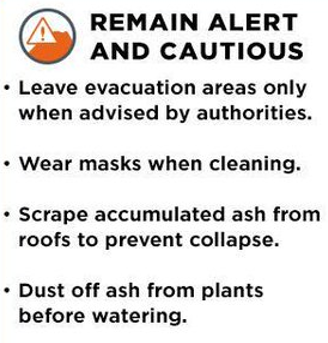DRRR
1/73
There's no tags or description
Looks like no tags are added yet.
Name | Mastery | Learn | Test | Matching | Spaced |
|---|
No study sessions yet.
74 Terms
Disaster
large-scale destructive events that causes great damage or loss of life.
Natural disaster
natural processes that occur on earth with or without warning that affects the human losses, environment, and properties.
Humanmade, manmade, or human-induced disaster
threat having an element of human intent, negligence, or error.
Natural and humanmade disaster
Basic groups of disaster
Geological
land; earthquake, volcanic eruption, tsunami, landslides, floods, subsidence.
Hydrometeorological
water and atmosphere; typhoons, tornadoes, drought, thunderstorms, storm surges.
Anthropogenic
man or human activity; hazardous materials, acid rain, global warming.
Biological
life or natural scenarios or diseases; insect infestation, epidemic, wildfires.
geological, hydrometeorological, anthropogenic, biological
Classifications of Disaster
geographical location (above equator and faces western pacific)
Why Philippines is a disaster-prone country
roughly 20 typhoons.
How many typhoons do Philippines experience each year
pacific ring of fire
Why Philippines frequently experience earthquake
Pacific ring of fire
path along the Pacific Ocean characterized by active volcanoes and frequent earthquakes.
National Disaster Risk Reduction and Management Council (NDRRMC)
responsible for ensuring the protection and welfare of people during disasters and emergencies.
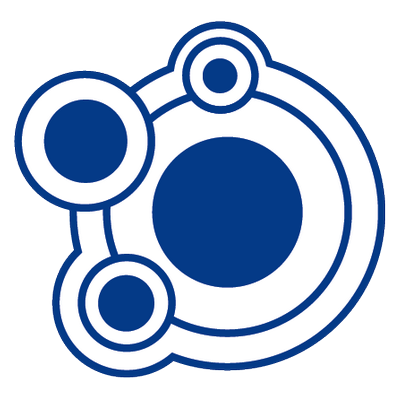
Philippine Institute of Volcanology and Seismology (PHIVOLCS)
responsible for monitoring and mitigating geological hazards, particularly those related to earthquakes and volcanic activity.

Philippine Atmospheric Geophysical and Astronomical Services Administration (PAGASA)
the purpose is to provide accurate and timely weather forecasts, warnings, and other information related to atmospheric and geological conditions.
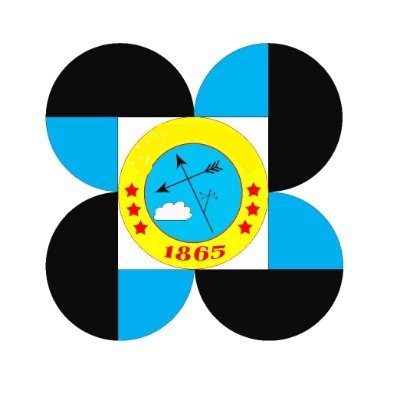
Padre Federico Faura
Spanish Jesuit priest who taught mathematics and created the Observatorio Meteorológico del Ateneo Municipal de Manila, now known as the Manila Observatory, founding father of cyclonic meteorology.
Global Warming
gradual increase in the earth’s temperature generally due to the greenhouse effect caused by increased levels of carbon dioxide.
fossil fuels (coal, oil, and gas), cutting down forests, using transportation
Greenhouse effect
Climate Change
refers to long-term shifts in temperatures and weather patterns.
Jose Clemente Salceda
Father of the Albay and Manila Declarations on Disaster Risk Reduction and Climate Change Adaptation.
Climate Change Act of 2009 (RA 9729)
climate change commission; plans about the country’s climate change awareness; lessen adverse effects of climate change.
National Disaster Risk Reduction and Management Act (RA 10121)
DRRMC; provide warning; disaster preparedness.
Survival Kit
pack of emergency equipment, including food, medical supplies, and tools, especially as carried by members of the armed forces.
Water
1 gallon per person per day; portable water is scarce, recommended to mix 4 drops of iodine or plain bleach with 1 liter of water and let it stand for 30 mins before drinking.
Food
non-perishable and easy to prepare.
Perishable
items that are likely to spoil, decay or become unsafe to consume.
Non-perishable
items that have long shelf life and does not require refrigeration.
Signaling instruments
flashlight, whistles, mirrors, glowsticks, AM/FM radios.
First aid kits
infection control precautions; medications.
Important documents
copies of personal documents; digitalized copies; proof of legal possessions; health records.
Multipurpose tools
Swiss knife, emergency blanket or sleeping bag, rope.
Clothing
sanitation and personal hygiene items.
Duplicate keys
keys, pen, and paper; copy of family emergency plan.
Pets and games
provision for pets; boardgames for children.
Dr. Renato Solidum Jr.
made the residents of Metro Manila be more aware of the risk that they face once the West Valley Fault moves; current secretary of DOST (Department of Science and Technology)
West Valley Fault
west segments which runs through Metro Manila to the cities of Marikina, Quezon City, Pasig, Makati, Taguig and Muntinlupa and moves in a dominantly dextral strike-slip motion.
The Big One
term used to describe damaging and strong earthquake scenarios; worst-case earthquake scenario in the Greater Metro Manila Area (GMMA)
Arko
mobile-based application that uses the extensive database of Project NOAH and DOST; flood mapping; real-time remote monitoring; keep people informed on floods or rainfall in areas.
Project READY or GMMA READY project
Aims to decrease the vulnerability of the Greater Metro Manila Area (GMMA) to natural hazards and increase their resilience.
Nationwide Operational Assessment of Hazards (Project NOAH)
the Department of Science and Technology's response to develop a more accurate, integrated, and responsive disaster prevention and mitigation system, especially in high-risk areas throughout the Philippines; shut down on Feb 28, 2017.
Disaster readiness
the process we use to mitigate, prepare, respond, and recover from disasters; save lives, protect property, and make sure the day the after a disaster is better than the day before.
Mitigate
assess, prevent, reduce.
Prepare
get supplies, make a plan, practice skills.
Recover
remove debris, rebuild, learn.
Respond
get alerted, stay safe, evacuate.
Earthquake
weak to violent shaking of the ground produced by the sudden movement of rock materials below the earth's surface.
1976 Moro Gulf 8.1 (8k casualties)
Worst earthquake (Philippines)
Earthquake Hazards
anything that includes a physical phenomenon associated with an earthquake that may produce adverse effects on human activities.
Primary Earthquake Hazards
direct results of the movement of the ground.
Ground shaking
vibration of the ground when an earthquake occurs, usually recorded in terms of intensity.
Landslide
wide range of ground movement such as rock fall, rockslide, debris slide, and shallow debris flow.
Surface rupture
offset of the ground surface when fault rupture extends to the surface; Any structure built across the fault is at risk of being torn apart.
Secondary Earthquake Hazards
results of the primary hazards, which can prove to be more catastrophic.
Tsunami
a series of waves caused by earthquakes or undersea volcanic eruptions or asteroid hitting the oceans.
Seiche
standing wave in an enclosed or partially-enclosed body of water.
Flooding
condition of becoming filled or covered with large amount of water.
Typhoon
incessant rain
Earthquake
tsunami
Fire
major secondary hazard associated with an earthquake has been the possibility of fires breaking out after an earthquake; candles or lantern, gas lines, electrical wires, and other utility wires.
Magnitude
number which is a measure of energy released in an earthquake; does not change.
Intensity
measure of strength of shaking during an earthquake.
Volcanic hazard
potentially dangerous volcanic process; lava flows, pyroclastic flows, ash.
Volcanic ash fall
deposition of ash from the air from eruption plumes emitted during explosive volcanic eruptions, magnesium, calcium, sodium, sulfur, copper, iron, and zinc.
Lahar
mudflow composed of rocky debris, water, and pyroclastic material; often along a river valley; cement-like consistency (dangerous); maximum temperature of 100% boiling point of water.
Volcanic gases
gases given off by active volcanoes; water vapor (H2O), carbon dioxide (CO2), and sulfur dioxide (SO2)
Lava flow
stream of molten rock that flows out of a volcano or volcanic vent.
Taal volcano 1911 (1,335 casualties)
Worst volcanic eruption (Philippines)
Mt. Pinatubo 1991
Strongest volcanic eruption (Philippines)
18
Active volcanoes (Philippines)
33
Overall volcanoes (Philippines)
Before volcanic eruption
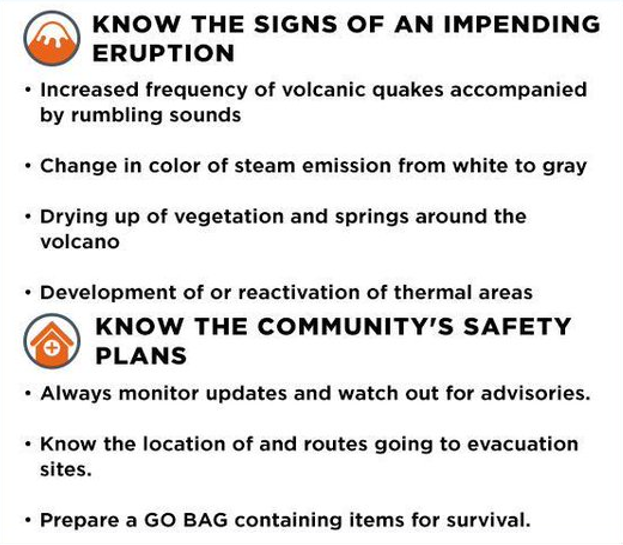
During volcanic eruption
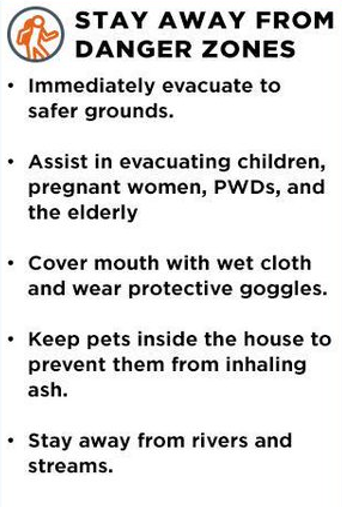
After volcanic eruption
